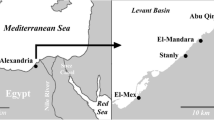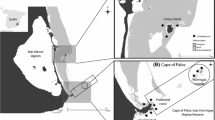Abstract
The interstitial fauna living within the sediments of a cave outflow situated in Verna (France) was mainly represented by two stygobiont species, the amphipod Niphargus rhenorhodanensis and the isopod Proasellus valdensis. Their population dynamics was observed by means of artificial substrates buried in the alluvia. Except for some individuals of Niphargus neither of these species was observed outside the cave and had low densities inside (0 to 30 individuals per species and per basket). These densities varied with time and depth within the sediment. The more superficial levels were more populated than the deeper ones. The reduction with depth was more marked for Proasellus than for Niphargus. Two distinct periods separated by a violent spate appeared during this study. The first period was characterized by high and relatively changing densities and the second by a low and constant one (except for the last sample of June 1989). Thus the recolonization of the sediment after the spate was very low. No correlations were observed between particulate organic matter (> 150 µm) and the number of individuals. The interpretation of the results took into account biological cycle features and preferential occupation of space for both species as well as the disturbance in the hydrological cycle and the phenomenon of competition.
Similar content being viewed by others
References
Angelier, E., 1953. Recherches écologiques et biogéographiques sur la faune des sable submergés. Arch. Zool. exp. gén. 90: 37–161.
Bou, C. & R. Rouch, 1967. Un nouveau champ de recherche sur la faune aquatique souterraine. C.R. acad. Sci. Paris 265: 369–370.
Chessel, D., 1978. Description non paramétrique de la dispersion spatiale des individus d'une espèce. In: Biométrie et Ecologie, Société française de Biométrie, Legay J. M. & R. Tomassone (ed.): 45–135.
Coleman, M. J. & H. B. N. Hynes, 1970. The vertical distribution of the invertebrate fauna in the bed of a stream. Limnol. Oceanogr. 15: 31–40.
Culver, D. C., 1972. Competition in spatially heterogeneous system: an analysis of simple cave communities. Ecology 54: 102–110.
Essafi, K., 1990. Structure et transfert des peuplements aquatiques souterrains à l'interface karst-plaine alluviale. Thèse de Doctorat, Lyon Fr.: 1–102.
Gaschignard, O., 1984. Impact d'une crue sur les macroinvert⋊6s benthiques d'un bras du Rhône. Verh. int. Ver. Limnol. 22: 1997–2001.
Ginet, R., 1969. Rythme saisonnier des reproductions de Niphargus (Crust. Amphip. hypogé). Annls Spéléol. 24: 387–397.
Golterman, H. L., 1975. Physiological limnology. An approach to the physiology of lake ecosystems. Elsevier Scient. Publ. Comp., Amsterdam, Oxford, New-York: 1–489.
Henry, J. P., 1976. Recherche sur les Asellidae hypogés de la lignée cavaticus (Crustacea, Isopoda, Asellota). Thèse de Doctorat d'Etat, Dijon (France), 1–270.
Hynes, H. B. N., 1970. The ecology of running water. Liverpool Univ. Press: 1–555.
Hynes, H. B. N., 1974. Further studies on the distribution of stream animals within the substratum. Limnol. Oceanogr. 19: 92–99.
Marmonier, P. & M. J. Dole, 1986. Les Amphipodes des sédiments d'un bras court-circuité du Rhône. Logique de répartition et réaction aux crues. Sci. Eau 5: 461–486.
Mathieu, J. & K. Essafi-Chergui, 1990. Le peuplement aquatique interstitiel à l'interface karst/plaine alluviale. 1. Cas d'une alimentation en eau essentiellement karstique. Mém. Biospéol. 17: 113–122.
Mathieu, J., D. Martin & P. Huissoud, 1984. Influence des conditions hydrologiques sur l'evolution de la structure spatiale et la démographie d'une population de l'Amphipode Niphargus rhenorhodanensis. Premiers resultats. Mém. Biospéol. 11: 27–36.
Mathieu, J., D. Debouzie & D. Martin, 1987. Influence des conditions hydrologiques sur la dynamique d'une population phréatique de Niphargus rhenorhodanensis (Amphipode souterrain). Vie Milieu 37: 193–200.
Minshall, G. W., 1988. Stream ecosystem theory: a global perspective. J.N. Am. Benthol. Soc. 7: 263–288.
Resh, V. H., A. V. Brown, A. P. Covich, M. E. Gurtz, H. W. Li, G. W. Minshall, S. R. Reice, A. L. Sheldon, J. B. Wallace & R. C. Wissmar, 1988. The role of disturbance in stream ecology. J.N. Am. Benthol. Soc. 7: 433–455.
Tabacchi, E., 1990. A sampler for interstitial fauna in alluvial rivers. Regulated rivers: research & management 5: 177–182.
Thioulouse, J., 1989. Statistical analysis and graphical display of multivariate data on the Macintosh. Comp. Appl. Biosci. 5: 287–292.
Turquin, M. J., 1975. Cycle biologique et rythme de ponte chez les Crustacés aquatiques troglobies. C. R. acad. Sc. Paris 280: 2033–2036.
Author information
Authors and Affiliations
Rights and permissions
About this article
Cite this article
Mathieu, J., Essafi-Chergui, K. & Culver, D.C. Variations in the structure of stygobiont crustacean populations (Niphargus rhenorhodanensis and Proasellus valdensis) within the sediments of a karst outflow. Hydrobiologia 231, 41–49 (1992). https://doi.org/10.1007/BF00008529
Received:
Revised:
Accepted:
Issue Date:
DOI: https://doi.org/10.1007/BF00008529




